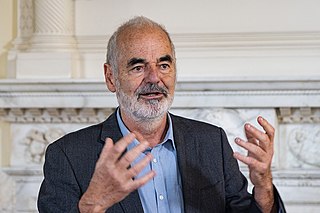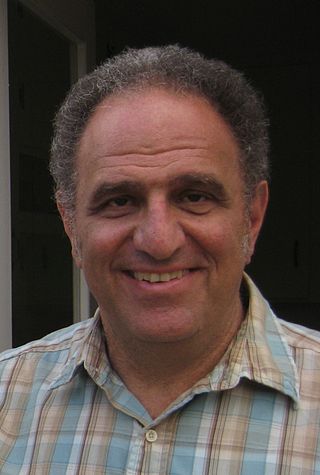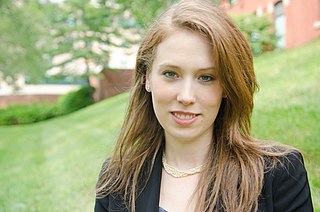
In statistics, probability density estimation or simply density estimation is the construction of an estimate, based on observed data, of an unobservable underlying probability density function. The unobservable density function is thought of as the density according to which a large population is distributed; the data are usually thought of as a random sample from that population.

Sir David John Spiegelhalter is a British statistician and a Fellow of Churchill College, Cambridge. From 2007 to 2018 he was Winton Professor of the Public Understanding of Risk in the Statistical Laboratory at the University of Cambridge. Spiegelhalter is an ISI highly cited researcher.

Bradley Efron is an American statistician. Efron has been president of the American Statistical Association (2004) and of the Institute of Mathematical Statistics (1987–1988). He is a past editor of the Journal of the American Statistical Association, and he is the founding editor of the Annals of Applied Statistics. Efron is also the recipient of many awards.

In statistics, least-angle regression (LARS) is an algorithm for fitting linear regression models to high-dimensional data, developed by Bradley Efron, Trevor Hastie, Iain Johnstone and Robert Tibshirani.
Basílio de Bragança Pereira is a Brazilian statistician.
Jianqing Fan is a statistician, financial econometrician, and data scientist. He is currently the Frederick L. Moore '18 Professor of Finance, Professor of Operations Research and Financial Engineering, Professor of Statistics and Machine Learning, and a former Chairman of Department of Operations Research and Financial Engineering (2012–2015) and a former director of Committee of Statistical Studies (2005–2017) at Princeton University, where he directs both statistics lab and financial econometrics lab since 2008.

Robert Tibshirani is a professor in the Departments of Statistics and Biomedical Data Science at Stanford University. He was a professor at the University of Toronto from 1985 to 1998. In his work, he develops statistical tools for the analysis of complex datasets, most recently in genomics and proteomics.

Larry Alan Wasserman is a Canadian-American statistician and a professor in the Department of Statistics & Data Science and the Machine Learning Department at Carnegie Mellon University.
In statistics and, in particular, in the fitting of linear or logistic regression models, the elastic net is a regularized regression method that linearly combines the L1 and L2 penalties of the lasso and ridge methods.
Mark Johannes van der Laan is the Jiann-Ping Hsu/Karl E. Peace Professor of Biostatistics and Statistics at the University of California, Berkeley. He has made contributions to survival analysis, semiparametric statistics, multiple testing, and causal inference. He also developed the targeted maximum likelihood estimation methodology. He is a founding editor of the Journal of Causal Inference.
In statistics, the graphical lasso is a sparsepenalized maximum likelihood estimator for the concentration or precision matrix of a multivariate elliptical distribution. The original variant was formulated to solve Dempster's covariance selection problem for the multivariate Gaussian distribution when observations were limited. Subsequently, the optimization algorithms to solve this problem were improved and extended to other types of estimators and distributions.
Janet D. Elashoff is a retired American statistician, formerly the director of biostatistics for Cedars-Sinai Medical Center and professor of biomathematics at UCLA.
Hui Zou is currently a professor of statistics at the University of Minnesota.

Daniela M. Witten is an American biostatistician. She is a professor and the Dorothy Gilford Endowed Chair of Mathematical Statistics at the University of Washington. Her research investigates the use of machine learning to understand high-dimensional data.
Prototype methods are machine learning methods that use data prototypes. A data prototype is a data value that reflects other values in its class, e.g., the centroid in a K-means clustering problem.
Adele Cutler is a statistician known as one of the developers of archetypal analysis and of the random forest technique for ensemble learning. She is a professor of mathematics and statistics at Utah State University.
Andreas Buja is a Swiss statistician and professor of statistics. He is the Liem Sioe Liong/First Pacific Company professor in the Statistics department of The Wharton School at the University of Pennsylvania in Philadelphia, United States. Buja joined Center for Computational Mathematics (CCM) as a Senior Research Scientist in January 2020.

Sherri Rose is an American biostatistician. She is an associate professor of health care policy at Stanford University, and once worked at Harvard University. A fellow of the American Statistical Association, she has served as co-editor of Biostatistics since 2019 and Chair of the American Statistical Association’s Biometrics Section. Her research focuses on statistical machine learning for health care policy.
Robert L. Strawderman is an academic biostatistician and researcher who holds the Donald M. Foster, MD Distinguished Professorship in Biostatistics at the University of Rochester. He has served as chair of the Department of Biostatistics and Computational Biology since 2012. Strawderman's principal research interests include semiparametric methods for missing and censored data and statistical learning methods for risk and outcome prediction. Contributions in numerous other areas include inference and variable selection in the areas of dynamic treatment regimes and causal inference in mediation analysis and for recurrent events.
Layla Mosama Parast Bartroff is an American biostatistician whose research involves surrogate markers, predictive modelling, survival analysis, causal inference, and health care quality. Formerly a senior statistician and co-director of the Center for Causal Inference at the RAND Corporation, she is an associate professor of statistics and data sciences at the University of Texas at Austin. She is also a frequent newspaper and news magazine editorial writer on issues related to public health, supported as a Public Voices Fellow of The OpEd Project.







